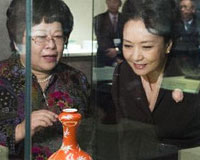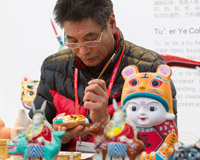Decline in Penmanship
The Chinese language is one of the most spectacular treasures of Chinese civilization. Inscriptions on oracle bones first emerged in the Shang Dynasty (1600-1100 BC). By the Zhou Dynasty (1100-256 BC), 4,500 characters had taken shape, 1,700 of which have been commonly recognized by archeologists. In the Qin Dynasty (221-206 BC), characters were unified. Though the forms of most Chinese characters have undergone great changes over past millennia, the essence of their structure remains the same.
Experts say that Chinese characters play a key role in passing on Chinese language and culture. According to Wang Ning, a professor at the Beijing Normal University and head of the editing team of the Table of General Standard Chinese Characters, part of the charisma of Chinese characters lies in their writing. "You may not have any special feeling just by looking at them. But by writing you get closer to them and sense their cultural meanings."
The number of people suffering computerinduced agraphia is rising with the advent of keyboard and voice recognition. It is an unavoidable fact that writing ability has declined in recent years.
Today all computers and mobile devices have pinyin in their input systems. After typing the pinyin , a list of characters with the same pronunciation pops up, from which users can choose the one they are looking for. Recognizing a character from a list is certainly much easier than recalling the many strokes needed to write it. Overreliance on electronic input methods is eroding people's memory for characters. For younger generations, writing has been replaced by typing.
A survey carried out by China Youth Daily shows that 98.8 percent of 2,517 respondents have encountered the embarrassment of "character amnesia." Only 38.9 percent of respondents regularly write by hand. Li He, a researcher at the Chinese Academy of Social Sciences' Institute of Philosophy, points out that writing habits have dramatically changed in the digital age. There are fewer opportunities for handwriting as it is more convenient and faster to type on keyboards.
In addition, Internet slang is becoming popular among students when messaging. For instance, the figure eight is a popular substitute for the word "no" or "not," as the pronunciation is similar in Chinese. "This change in people's writing habits leads to reduced interest in their native language, which may affect the inheritance of Chinese culture and civilization, a crisis that deserves attention," said Li Bo, guest compere of the Chinese Character Dictation Contest and associate professor at the Nanjing Normal University's School of Chinese Language & Literature.
Rekindling Passion in a Digital Age
China covers a large territory, home to many ethnic groups who speak a vast range of dialects. The Uygur language is spoken in Northwest China's Xinjiang while several dialects are spoken in Guangdong and Fujian provinces in the southeast. Therefore, Mandarin plays an important role in enhancing national cohesion.
This is why the downward spiral in language proficiency is ringing alarm bells. A survey launched by the State Language Work Committee reveals that over 65 percent of today's college students spend more than a quarter of their study time on foreign languages, especially English. At the same time, doctoral advisors complain that many masters and doctoral students are incapable of writing in fluent sentences and coherent logic. Incorrect characters are common as well.
Faced with the decline of the Chinese language, many are calling for a linguistic revival. Wang Xuming, ex-spokesman for the Ministry of Education, suggested canceling English classes in primary schools while attaching more importance to Chinese learning. His plea to society on his Weibo page is "free the children and save Chinese language." Six annual reports released by the Ministry of Education and the State Language Work Committee have called attention to students' degenerating proficiency in Chinese, including handwriting.
The Last Lesson by French author Alphonse Daudet has been frequently cited recently as the Chinese feel an urgent need to re-embrace their mother tongue. The story takes place after the Franco- Prussian War, in a French primary school forced to teach in German instead of the native language. The author describes how the teacher gives his last lesson in French and thereby demonstrates the loyalty of the French people to their mother tongue.
Chinese people have the same love for Chinese characters. In 2013, a manuscript by Lu Xun (1881- 1936), one of the greatest Chinese writers of the 20th century, sold for over RMB 6.5 million at an auction in China. In August 2013, an exhibition on the development of Chinese pictographs was launched at the Capital Museum in Beijing, and later made an international tour of such countries as Canada, Uzbekistan and Nepal. At the same time, the Table of General Standard Chinese Characters was finally released on www.gov.cn after 10 years of research. Including 8,105 characters, the list is the latest achievement on the standardization and classification of Chinese characters over the past 50 years.
Inspired by the renewed enthusiasm for the language, some companies have begun asking job applicants to complete writing tests at their interviews. A woman using the pseudonym Cangqiong online said she was stumped by writing tests when she attended a second round interview for a copywriting position, since she is more used to typing on computers. Her experience was extensively discussed online. Many netizens foresee that handwriting may become an essential part in more job interviews.
The Chinese Character Dictation Contest aims to arouse the public's love for characters. Watching the game is actually "a self-education course for the whole country," according to linguist Jiang Lansheng. "Such education does not place people under pressure but is fairly effective." Guan Zhengwen hopes that the game will go on for 50 years or longer, and that getting stuck into Chinese characters will become an annual festivity.

|

|
 |
| 2014 APEC:China displays its culture and history |
Colorful exhibit showcases Asian cultures
|
APEC press center decorated with Chinese elements
|
